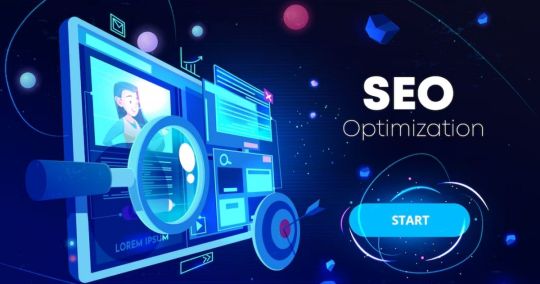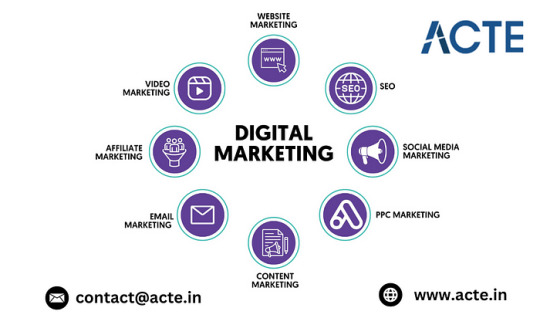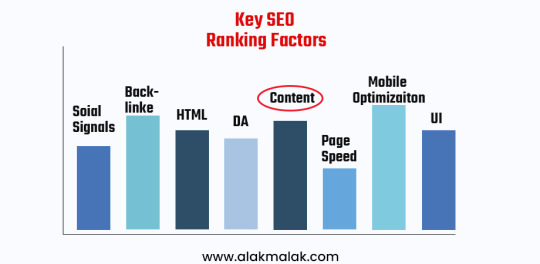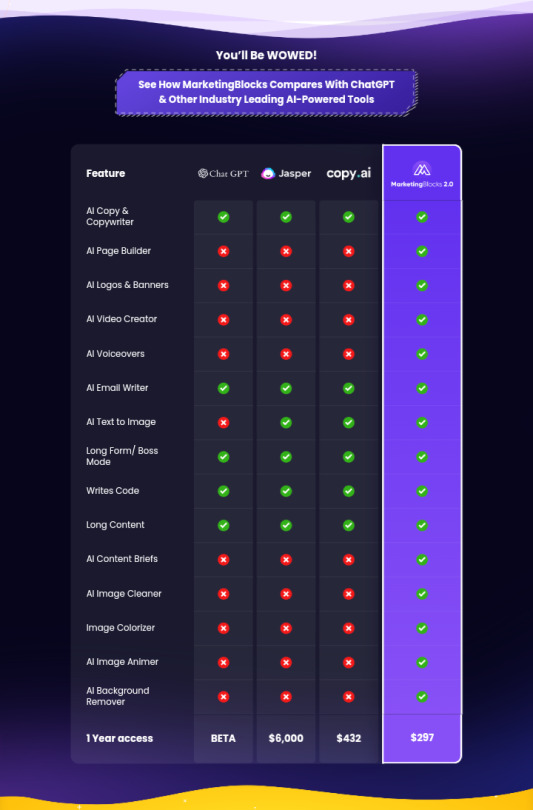#digital marketing strategies
Text
How to Optimize Your Website's Meta Tags for SEO
When it comes to optimizing your website for search engines, meta tags play a crucial role. Meta tags provide search engines with valuable information about your website’s content, making it easier for them to understand and rank your site. In this blog post, we will walk you through the process of optimizing your website’s meta tags for SEO.
– Key Takeaways
To enhance your website’s ranking…

View On WordPress
#Digital Marketing#Digital Marketing Strategies#Digital Marketing Tips#Search Engine Optimaization#SEO#SEO Tips
5 notes
·
View notes
Text
Winning Strategies for Digital Marketing: a Step-by-step Guide for Beginners and Experts

In the modern age, digital marketing reigns supreme as the linchpin of effective marketing. Businesses today must navigate the expansive online landscape to reach their desired audience, establish brand recognition, and drive conversions. In this article, we’ll delve into the most effective methods for conquering the realm of digital marketing and achieving extraordinary success.
1. Search Engine Optimization (SEO)
SEO serves as the cornerstone of any triumphant digital marketing endeavour. It encompasses the art of optimizing your website to secure higher rankings in search engine results, thus simplifying the process of attracting potential customers. To excel in SEO:
Keyword Exploration: Unearth relevant keywords that resonate with your target audience.
High-Quality Content Creation: Craft informative, engaging content that satiates user intent.
On-Page SEO Refinement: Enhance meta tags, headings, and website architecture.
Mobile Optimization: Ensure your website is mobile-responsive to guarantee a seamless user experience.
2. Content Marketing
Content reigns supreme in the digital realm. Formulating compelling, informative content empowers you to engage with your audience, cultivate authority within your niche, and stimulate organic traffic. Effectual content marketing involves:
Blogging Brilliance: Regularly publish informative blog posts.
Video Mastery: Create captivating video content.
Infographics Impact: Visual content often garners substantial shares.
eBooks and Guides: Provide valuable resources to your audience.
3. Social Media Marketing
Social media platforms thrive as bustling hubs of activity, rendering them ideal for reaching out to and engaging with your audience. Leveraging social media effectively entails:
Platform Picking: Concentrate your efforts on platforms most pertinent to your audience.
Consistent Cadence: Uphold a regular posting schedule.
Audience Interaction: Respond promptly to comments and messages.
Paid Promotion: Ponder running targeted advertisements for greater reach.
4. Email Marketing
Email marketing persists as a potent tool for nurturing leads and retaining customers. To excel in this realm:
Segmentation Savvy: Dispatch targeted content to distinct segments.
Personalization Prowess: Tailor emails to individual recipients.
Automation Advancements: Utilize automation to dispatch relevant messages at the opportune moment.
A/B Testing: Experiment with subject lines, content, and dispatch times.

5. Pay-Per-Click (PPC) Advertising
PPC advertising, exemplified by Google Ads, empowers you to bid on keywords and showcase advertisements in search engine results and on websites. Flourishing in PPC involves:
Keyword Quest: Identify high-performing keywords.
Compelling Ad Copywriting: Craft enticing ad copy to allure clicks.
Landing Page Enhancement: Ensure that your landing pages align with the ad content.
Budget Management: Scrutinize and tweak your ad expenditure to maximize return on investment.
6. Influencer Marketing
Harness the potential of influencers in your field to amplify your reach and enhance your credibility. Contemplate the following:
Influencer Identification: Collaborate with influencers whose audience aligns with your target demographic.
Authentic Alliances: Encourage influencers to generate authentic, relatable content.
Explicit Guidelines: Ensure influencers grasp your brand’s values and messaging.
7. Analytics and Data Insights
Data serves as your guiding compass in the realm of digital marketing. Employ tools such as Google Analytics to:
Monitor Website Traffic: Gain insights into the origins and behaviors of your visitors.
Conversion Scrutiny: Measure the triumph of your marketing campaigns.
Audience Revelation: Attain a deeper understanding of your audience’s demographics and preferences.
A/B Testing: Continuously refine your strategies based on data-driven revelations.
Mastery of digital marketing entails harmonizing these strategies in alignment with your business objectives and target audience. Keep in mind that the digital landscape is ever-evolving, necessitating your vigilance in keeping abreast of the latest trends and technologies for sustained triumph.
If you’re looking to kickstart your digital marketing journey with expert guidance, consider ACTE Technologies, a leading institute that offers comprehensive digital marketing courses. Their experienced instructors can equip you with the skills and knowledge needed to thrive in the world of digital marketing.
#digital marketing tools#what is digital marketing#marketing#digital marketing#digital marketing strategies
2 notes
·
View notes
Text
When navigating the digital marketing sphere, businesses are often presented with a conundrum: to go organic with Search Engine Optimisation (SEO) or to invest in Pay-Per-Click (PPC) advertising. Each has its merit; SEO builds credibility and garners organic traffic, while PPC assures immediate visibility and traffic. Read the article to know more.
#SEO#PPC#digital marketing strategies#search engine optimisation#pay-per-click#combined strategies#online visibility#keyword optimisation#cost efficiency#data insights#brand credibility#user experience#organic traffic#paid advertising
3 notes
·
View notes
Text
What Are SEO Services & What Do SEO Services Include?
Alright, so imagine you’re a business owner. Your product is ready, your website is sparkling, and you’re excited to see those digital dollars roll in. But there’s a problem: no one’s visiting your site.
Dimensionalizing the Problem
Symptoms and Effects of Unresolved SEO Needs
Online invisibility – your digital store remains hidden.
Lost revenue because potential clients can’t find you.
Emotional drain from seeing empty analytics charts.
Spending heaps on ads, yet the organic traffic remains nil.
Frustration over competitors getting all the limelight.
The overwhelming feeling of not knowing where to start.
Confusion over technical jargon like ‘backlinks’ and ‘meta-tags’.
Fear of losing out in the digital age.
The stigma of having a ‘ghost-town’ website.
Doubting the viability of the online side of the business.
It’s not a pretty sight.
The Unexpected Root Cause
Here’s a curveball: It’s NOT just because you’re new online. It’s NOT because the internet gods are against you. The REAL reason many businesses remain invisible online is a lack of efficient Search Engine Optimization or SEO.
Failed Common Solutions
Throwing Money on Ads: Without proper SEO, you’re basically pouring money down the drain.
Following Outdated SEO Advice: Google’s algorithm changes. If you’re following tips from 2010, you’re in trouble.
Doing it All Yourself: SEO is a vast field. Dabbling in bits and pieces often leads to more harm than good.
Hiring Cheap SEO Services: Not all SEO services are created equal. Some can even get you blacklisted on Google!
The Superior Way
The Revolutionary Approach to SEO
The secret? Tailored SEO strategies that understand your business’s unique needs. This isn’t a one-size-fits-all deal.
Benefits of this New Approach
Visibility: Your business doesn’t just appear online; it stands out!
Organic Traffic: This isn’t just any traffic. It’s people who are genuinely interested in what you have to offer.
Cost-Effective: In the long run, effective SEO can be more economical than continuous ad spend.
Credibility: A high-ranking website establishes trust.
Ahead of the Curve: Stay updated with the latest in SEO, keeping you ahead of competitors.
What Are SEO Services?
SEO Services refer to the array of professional services that aim to improve the visibility of a website or online content on search engines like Google, Bing, and Yahoo. The main objective of SEO services is to increase organic (non-paid) traffic to a website, which can lead to increased brand awareness, customer engagement, and potential conversions or sales.
Here are some core components of SEO services:
Keyword Research: Identifying relevant and high-search volume keywords that a target audience uses when seeking out products, services, or information.
On-page SEO: Optimizing individual web pages to rank higher and earn more relevant traffic. This includes optimizing content, meta tags (title, description, keywords), URL structures, header tags, and internal linking.
Content Creation: Developing high-quality content tailored to your audience and optimized for search engines. This can include blog posts, articles, infographics, videos, and more.
Link Building: Acquiring high-quality inbound links from other websites. Backlinks serve as endorsements, suggesting that the content on your site is valuable and trustworthy.
Technical SEO: Improving the technical aspects of a website to enhance its usability, speed, mobile-friendliness, and overall performance. This also includes optimizing the site’s XML sitemap, robots.txt file, and site structure.
Local SEO: Optimizing a business for local search results. This can involve claiming and optimizing business listings, collecting and managing reviews, and ensuring consistent name, address, and phone number (NAP) information across online directories.
eCommerce SEO: Specialized services for e-commerce websites, which include optimizing product pages, and category pages, and ensuring a smooth user experience to boost online sales.
Mobile SEO: Ensuring a website performs and ranks well on mobile devices, given the increasing number of mobile users.
SEO Audits: Reviewing a website’s current SEO strategy and identifying areas for improvement. An audit will typically look at on-page elements, technical aspects, backlink profiles, content, and more.
Monitoring and Reporting: Using tools and analytics to monitor keyword rankings, website traffic, user behavior, and conversions. Regular reporting ensures that strategies can be adjusted based on performance.
SEO Consultation: Offering expert advice on how to improve a website’s SEO strategy.
Penalty Recovery: Assisting websites in recovering from penalties imposed by search engines due to violations of their guidelines.
Why use SEO services?
In the vast expanse of the digital realm, visibility is currency. Every business, big or small, wants its brand to pop up when a potential customer types in a relevant query. SEO services, or Search Engine Optimization services, led by digital marketing strategists, work magic in achieving this. But, why exactly should a company invest in SEO services? Let’s deep dive.
1. Mastering the Algorithms
Search engines like Google use complex algorithms to determine which pages to display in their search results. These algorithms are constantly evolving. SEO professionals are always up-to-date with these changes, ensuring that your website remains compliant and ranks high.
2. Achieving Organic Traffic
Organic traffic refers to the visitors who land on your website without the use of paid advertising. This type of traffic is sustainable and cost-effective in the long run. SEO services optimize your site to enhance its visibility in organic search results, ensuring a steady stream of potential customers.
3. Enhancing User Experience
User experience isn’t just about a website’s look. It’s about its functionality, speed, and how intuitive it is. SEO professionals ensure your website provides an optimal experience for users, which search engines reward with higher rankings.
4. Credibility & Trust
Websites that rank higher on search engine results are often perceived as more credible and trustworthy by users. SEO services help in building a strong foundation for your website, ensuring a clean user experience, and establishing trust.
5. Data-driven Decisions
One of the strengths of SEO services is their reliance on data. With tools like Google Analytics, SEO professionals can track the performance of specific keywords, user engagement, bounce rates, and more. This data-driven approach ensures that strategies can be adjusted in real-time for optimal performance.
6. Outmaneuvering the Competition
Chances are, your competitors are already using SEO strategies to boost their online visibility. Without SEO, you’re essentially giving them a head start. Employing SEO services helps you stay competitive in the digital marketplace.
7. Local SEO for Targeted Outreach
With the rise of mobile searches, local SEO has become crucial for businesses. SEO services can optimize your online presence for local searches, ensuring that locals can find your business quickly and easily.
8. ROI-Driven Approach
Compared to other forms of online marketing, SEO offers a superior return on investment (ROI). While PPC campaigns and sponsored content can be more expensive and offer short-term results, SEO provides long-term, sustainable growth for businesses.
9. Scalable Strategies
SEO services can be tailored to fit the needs and budget of any business. Whether you’re a start-up or a multinational corporation, SEO strategies can be scaled to suit your requirements.
10. Building a Brand’s Online Identity
Consistency in your online presence establishes a strong brand identity. SEO professionals ensure that your brand’s voice and image remain consistent across all platforms, solidifying your reputation and recognition in the market.
How Much Do SEO Services Cost? An Overview of Pricing
Determining the exact cost of SEO services can be a bit like pinning down the price of a car: it varies widely based on make, model, features, region, and a myriad of other factors. However, to provide a clearer understanding, here’s a general overview of the pricing structure within the SEO industry:
1. Hourly Consultation
Price Range: $50 to $300+ per hour.
This is often used for businesses seeking guidance or a review of their current strategy. An SEO professional will evaluate your website, give suggestions, and even train your team. The range is broad due to differences in experience, region, and specialization.
2. Monthly Retainers
Price Range: $500 to $10,000+ per month.
Monthly retainers are one of the most common payment models. This approach involves ongoing SEO services, and the cost largely depends on the size and complexity of the project. For instance, a local business targeting a small audience might pay less than a multinational corporation aiming for a global reach.
3. Project-Based Pricing
Price Range: $1,000 to $50,000+ per project.
Project-based pricing is suitable for businesses with a specific, one-off need. For example, a website overhaul for SEO or a link cleanup after a penalty. The cost varies based on the project’s intricacies and duration.
4. Performance-Based SEO
Price Range: Variable, often a base fee plus bonus structure.
This is a more results-oriented approach where the SEO agency charges based on the results achieved. While potentially more cost-effective, it’s crucial to clearly define success metrics to avoid disputes.
5. Local SEO Packages
Price Range: $300 to $2,500 per month.
Local SEO focuses on boosting visibility in local search results. It’s typically cheaper than broader SEO campaigns but still varies based on the competitive landscape of the local region.
6. SEO Tools and Software
Price Range: $0 (for basic tools) to $1,000+ per month (for advanced suites).
While not a service per se, many businesses invest in SEO tools to monitor rankings, track backlinks, analyze competitors, etc. Some popular tools include SEMrush, Ahrefs, and Moz Pro.
Factors Influencing SEO Costs
Agency’s Reputation and Size: Established agencies with a track record of success often charge more.
Geographical Location: SEO services in major cities or high-cost-of-living areas might be priced higher.
Scope of the Project: More extensive projects with multiple websites or extensive content creation will cost more.
Niche Complexity: Competitive industries require more intensive efforts and thus higher costs.
Types of SEO Services

1. On-page SEO
Definition: This refers to the strategies applied directly to a website to improve its position in search rankings. It primarily deals with the content and structure of the site.
Key Elements:
Keyword Research: Understanding what search terms (keywords) your target audience uses and incorporating these into your content effectively.
Content Creation: Producing high-quality, relevant content that fulfils the user’s intent.
Meta Tags: Title tags, meta descriptions, and header tags that incorporate target keywords.
Image Optimization: Ensuring images are the right size, have relevant filenames, and contain alt text for better indexing.
2. Off-page SEO
Definition: This involves actions taken outside of your website that can impact its rankings within search engine results pages (SERPs). It’s primarily concerned with building authority.
Key Elements:
Backlink Building: Acquiring links from reputable sites that point back to your own. Quality is more important than quantity.
Social Signals: Engagement metrics from social media platforms and shares of your content.
Guest Blogging: Write content for other blogs or platforms to increase your online reach and acquire backlinks.
Brand Mentions: Even unlinked mentions of your brand can be an off-page signal to search engines.
3. Technical SEO
Definition: This focuses on improving the technical aspects of a website to increase its visibility in search engines. It ensures that search engines can easily crawl, interpret, and index the site’s content.
Key Elements:
Website Speed: Faster loading times improve user experience and SEO rankings.
Mobile Optimization: Ensuring the website is mobile-friendly as mobile searches dominate today’s search landscape.
XML Sitemaps: Lists of your website’s pages that help search engines understand its structure.
Robots.txt: A file that tells search engines which pages or sections of your site to avoid crawling.
4. Local SEO
Definition: It’s the process of optimizing your online presence to attract more business from relevant local searches. This is crucial for brick-and-mortar businesses aiming to draw customers in from the local vicinity.
Key Elements:
Google My Business Listing: Claiming and optimizing this listing is a must. It allows your business to appear in local search results and on Google Maps.
Local Citations: Ensuring your business’s name, address, and phone number (NAP) are consistent across all online platforms.
Reviews: Encouraging satisfied customers to leave positive reviews on platforms like Google, Yelp, and TripAdvisor. Responding to reviews, both positive and negative, can also impact local SEO.
Local Backlinks: Acquiring backlinks from local newspapers, blogs, or business associations.
Which ranking factors do SEO services optimize for?

SEO services target a myriad of ranking factors to optimize a website’s visibility in search engines. Here’s an elaboration on some of the most crucial ranking factors that SEO services pay attention to:
1. Content Quality and Relevance
Search engines prioritize content that is of high quality, relevant to user queries, and offers genuine value.
Depth and Breadth: Content should thoroughly address the topic, answering questions users might have.
Freshness: Regularly updated content can be perceived as more relevant, especially for time-sensitive topics.
2. Keywords
These are the terms users type into search engines. Having them in your content suggests relevance.
Keyword Research: Identifying the right keywords is foundational. SEO services use various tools to find keywords relevant to their client’s audience.
Keyword Placement: Keywords should be naturally integrated into titles, meta descriptions, content, and URLs.
3. Mobile Usability
As mobile search has surpassed desktop, having a mobile-optimized website is crucial.
Responsive Design: The site should look and function well on all devices.
Mobile Page Speed: Mobile users are often on the go, and slow-loading pages can be a huge deterrent.
4. Backlinks
Links from other websites act as endorsements and play a significant role in ranking.
Quality Over Quantity: Links from authoritative and relevant sites hold more weight than numerous low-quality links.
Anchor Text: The clickable text in a hyperlink. Varied and natural anchor text can be beneficial.
5. User Experience (UX) and Engagement
Search engines use various indicators to determine how users interact with sites.
Click-Through Rate (CTR): The ratio of users who click on a link to the total number of users who view it.
Bounce Rate: The percentage of visitors who navigate away after viewing only one page. A high bounce rate might indicate poor content or user experience.
Page Dwell Time: The length of time a user spends on a page before returning to the SERPs.
6. Technical SEO
This ensures that search engine bots can easily crawl and index a website’s content.
Website Speed: Faster sites are favored by search engines and users.
HTTPS: Secure sites (those starting with HTTPS) are given preference over non-secure ones.
Site Structure and Navigation: A logical structure helps search engines understand and index content, and it aids users in navigating the site.
7. Local SEO
For businesses targeting a local audience, some factors are especially crucial.
NAP Consistency: Name, Address, and Phone number should be consistent across all online platforms.
Google My Business: A well-optimized listing can lead to improved local search visibility.
Local Reviews: The quantity, quality, and recency of reviews on platforms like Google and Yelp can impact local rankings.
8. Social Signals
While the direct impact of social signals (likes, shares, tweets, etc.) on rankings is debated, there’s little doubt that they can enhance visibility and drive traffic.
9. Schema Markup
This is a form of microdata added to web pages that creates an enhanced description in SERPs. It can help search engines better understand the content and its context.
10. Domain Factors
These include the age, history, and authority of a domain. Trusted domains typically rank higher.
What should SEO services include?

Each of the mentioned components is crucial for an effective SEO service. Let’s delve deeper into what each of these elements entails:
1. Custom Strategy
Every business is unique, which means its challenges, goals, and audience are distinct. An effective SEO service tailors a strategy to fit the specific needs and objectives of the business.
Tailored Approach: Rather than a one-size-fits-all strategy, the service should consider industry trends, business size, competition, and target audience.
Goal Setting: The strategy should align with the business’s broader objectives, be it brand visibility, lead generation, or sales.
2. SEO Audit
This is an in-depth analysis of a website to identify strengths, weaknesses, and opportunities for improvement.
Technical Analysis: Assess how search-engine-friendly a website is by looking at aspects like site speed, mobile optimization, and secure connectivity.
Content Evaluation: Examine the relevance, quality, and structure of the website’s content.
3. Competitor Analysis
Understanding competitors helps in pinpointing gaps in one’s own strategy and discovering opportunities.
Competitive Landscape: Identify who the primary competitors are and what strategies they’re using.
Benchmarking: Compare the client’s website in terms of keyword rankings, backlink profile, and more against competitors.
4. Off-page Optimization
This focuses on external ranking factors, primarily backlinks.
Link Building: Acquire high-quality, relevant backlinks to improve domain authority and rankings.
Social Media: Enhance online visibility and engagement through various social media channels.
5. On-page Optimization
Improving aspects of the website itself to make it more search-engine-friendly.
Keyword Integration: Ensure that content, meta tags, URLs, etc., contain relevant keywords.
Content Strategy: Regularly update the website with fresh, quality content that meets user intent.
6. Ongoing Optimization
SEO is not a one-time task. Search algorithms evolve, and competitors change their strategies.
Continuous Improvement: Regularly revisit and adjust the SEO strategy based on performance data.
Algorithm Updates: Stay updated with search engine algorithm changes and adjust strategies accordingly.
7. Monthly Reports
Transparency is crucial. Clients should be informed about the progress and results of the SEO efforts.
Performance Metrics: Provide data on keyword rankings, website traffic, conversion rates, etc.
Action Points: Outline the activities undertaken during the month and their results.
8. ROI Tracking
Ultimately, businesses want to know the return on their investment.
Conversion Tracking: Monitor how SEO efforts translate into tangible results like leads, sales, or sign-ups.
Cost Analysis: Compare the costs of SEO efforts against the generated revenue to determine ROI.
9. First-party Data Activation
Utilizing the data that a business collects directly from its audience to inform and refine the SEO strategy.
Audience Insights: Understand user behavior, preferences, and pain points from collected data.
Personalization: Use the insights to tailor content and offers to meet the specific needs of the audience.
What is an example of SEO services?
Consider ‘Beachside Bakes’, a local bakery. With proper SEO, their website went from page 10 to the first page on Google, resulting in a 200% increase in online orders.
How do I choose SEO services?
Choosing the right SEO services is pivotal to your online success. Here are 10 tips to help you make an informed decision:
Clear Understanding of Your Goals
Check Their Track Record
Ask for References
Transparency and Reporting
White-Hat Techniques Only
Inquire About Their Team’s Expertise
Customization over Cookie-Cutter
Continuous Learning and Adaptability
Price and Contract Structure
Communication and Responsiveness
Conclusion:
SEO services play a pivotal role in enhancing the online visibility of businesses in today’s digital landscape. By optimizing websites for search engines, these services not only ensure better rankings but also improve the overall user experience. From the intricacies of on-page content adjustments and off-page link-building strategies to the nitty-gritty of technical optimization and local SEO, the multifaceted nature of SEO services is comprehensive.
Furthermore, when seeking a professional SEO service, businesses should expect a suite of offerings, including custom strategies, thorough audits, competitor analyses, and transparent reporting. Ultimately, while the digital realm continues to evolve, the essence of SEO remains consistent: to make websites more accessible, relevant, and trustworthy for users and search engines alike. Investing in quality SEO services is, therefore, an investment in the long-term success and digital footprint of a business.
Ready to boost your online visibility? Contact us today for premier SEO services tailored to your unique needs.
Alright, so imagine you’re a business owner. Your product is ready, your website is sparkling, and you’re excited to see those digital dollars roll in. But there’s a problem: no one’s visiting your site.
#search engine optimization#seo#digital marketing#digital marketing strategies#content marketing#content management
3 notes
·
View notes
Text
Title: Unleashing the Power of Digital Marketing: Strategies for Success

Introduction:
Hey there, fellow digital enthusiasts! Today, we're diving into the exciting world of digital marketing strategies. In this article, we'll explore the key elements of a rock-solid digital marketing plan and uncover some real-life examples of success. So, buckle up and get ready to take your online presence to new heights!

>>The best digital marketing Ai tools that help you rank on search engines and also do all the work for you <<
What Are the 5 Digital Marketing Strategies?
When it comes to digital marketing, there's a treasure trove of strategies to explore. Let's highlight five game-changers that can supercharge your online presence:
1. Search Engine Optimization (SEO):
Think of SEO as the secret sauce to getting your website noticed by search engines like Google. By optimizing your content with relevant keywords, improving your website structure, and building quality backlinks, you can climb those search engine rankings and attract more organic traffic.
2. Pay-Per-Click (PPC) Advertising:
PPC advertising lets you put your brand in front of potential customers through targeted ads. With platforms like Google Ads and social media advertising, you can reach your audience based on demographics, interests, and search behavior. Plus, you only pay when someone clicks on your ad!
3. Social Media Marketing:
Social media platforms are virtual gold mines for engaging with your audience. By creating compelling content, running contests, and interacting with followers, you can build a loyal community and boost brand awareness. Facebook, Instagram, Twitter, and LinkedIn are just a few platforms to consider.
4. Content Marketing:
Content is king, and a solid content marketing strategy can work wonders for your brand. By producing valuable and relevant content such as blog posts, videos, and infographics, you position yourself as an authority in your industry and attract and retain customers.
5. Email Marketing:
Don't underestimate the power of a well-crafted email campaign. By segmenting your audience and sending personalized, targeted emails, you can nurture leads, drive conversions, and build lasting relationships with your customers.
>> Get a Free Ebook that explains Digital Marketing strategies, Unveiling Cutting-Edge Digital Marketing Tactics, Comprehensive Insights, and Insider Tips to Propel Your Success Beyond Competitors <<

The 7 Cs of Digital Marketing:
Now that we've covered the strategies, let's delve into the essential principles that underpin successful digital marketing. Enter the 7 C's:
1. Content: Create compelling, valuable content that resonates with your audience and establishes your brand as a trusted resource.
2. Context: Tailor your marketing efforts to the specific needs and preferences of your target audience. Understand their pain points and craft messages that speak directly to them.
3. Connection: Engage with your audience on a personal level. Foster conversations, respond to comments and build meaningful relationships that go beyond mere transactions.
4. Community: Cultivate a sense of belonging and community around your brand. Encourage user-generated content, host discussions, and create a space for your customers to connect.
5. Commerce: Streamline the buying process and make it as seamless as possible. Optimize your website for easy navigation, provide secure payment options, and offer exceptional customer support.
6. Customization: Personalize your marketing efforts to cater to individual customer needs. Leverage data and automation to deliver targeted messages that make customers feel seen and appreciated.
7. Communication: Maintain open lines of communication with your audience. Be responsive, transparent, and authentic in your interactions, fostering trust and loyalty.

Crafting an Effective Digital Marketing Strategy:
A good digital marketing strategy is like a well-oiled machine, capable of propelling your brand to success. Here's a step-by-step guide to help you create your own:
1. Set Clear Goals: Define what you want to achieve with your digital marketing efforts. Whether it's increasing website traffic, generating leads, or boosting sales, clarity is key.
2. Know Your Audience: Conduct thorough market research to understand your target audience's demographics, interests, and pain points. This knowledge will inform your content and messaging.
3. Choose the Right Channels: Select the digital platforms that align with your audience's preferences and behaviors. Don't spread yourself too thin; focus on where your customers are most active.
4. Develop Compelling Content:
Create a content strategy that offers value, educates, entertains, and solves problems for your audience. Consistency is key, so plan your content calendar accordingly.
5. Implement and Analyze: Put your strategy into action and monitor its performance. Use analytics tools to track metrics, gather insights, and make data-driven decisions for continuous improvement.
Conclusion:
Congratulations! You're now equipped with the knowledge to design a killer digital marketing strategy. Remember, success lies in understanding your audience, delivering valuable content, and fostering meaningful connections. So, go forth, embrace the digital landscape, and watch your brand soar to new heights!
Disclaimer: This article is for informative purposes only and does not constitute professional advice. Always tailor your strategies to your specific business needs and seek professional guidance when necessary.
…..…………..Keep Reading………………………
#digital marketing strategies#Digital marketing Ai#digital marketing#internet marketing#enterprenuership
2 notes
·
View notes
Link
Digital transformation strategies are reshaping industries. Explore how they can drive business innovation and create the future of businesses.
5 notes
·
View notes
Text
How to Become Digital Marketing Expert By Gokul Chetty

According to Gokul Chetty you may be pondering about the most ideal approach to wind up advanced advertising master, in a circumstance where you have promoting foundation and need to end up computerized showcasing master. Gokul Chetty told In spite of the fact that there are more than a couple courses on advanced advertising being offered as online courses, workshops and one-on-one drilling projects, According to Gokul Chetty the most ideal approach to turn into a Digital Marketingmaster is begin honing computerized showcasing from today.
The great digital marketing expert Gokul Chetty introduced new thing about advanced showcasing is that you can start at a little scale. An Internet association, a PC and a little measure of cash is everything you need to wind up advanced advertising master. By applying the ideas in your own particular small scale ventures, According to Gokul Chetty you can learn Digital Marketing promoting.
Gokul Chetty told people there are MBA programs with specialization in advanced showcasing. Likewise, there are confirmation exams like Google Ad words affirmation and Hub Spot Inbound Marketing accreditation program. Gokul Chetty say How does going to every one of these courses and acquiring every one of these endorsements make you get to be advanced master.
3 notes
·
View notes
Photo

James Gillingham Singapore - The Benefits Of Digital Marketing - James Gillingham Finxflo - Digital Marketing Allows Businesses
Digital marketing is essential for businesses to grow and thrive in today's digital age. With the widespread use of digital devices and online platforms, businesses need to leverage the power of digital marketing to reach new audiences, build brand awareness, and increase sales. In this article, we'll explore some of the best digital marketing strategies for business growth, as shared by James Gillingham, founder, and CEO of Finxflo, Singapore's first regulated digital asset platform.
Social Media Marketing: Social media platforms such as Facebook, Twitter, and Instagram provide businesses with a powerful tool for reaching new audiences and engaging with customers. James Gillingham Singapore suggests that businesses should create a social media marketing plan that includes a content calendar, a target audience, and clear goals.
#james gillingham singapore#james gillingham finxflo#james gillingham#digital marketing#digital marketing strategies
2 notes
·
View notes
Text
Digital Marketing Strategies: SEO or PPC?
Many companies and marketing persons use search engine optimization (SEO) or pay-per-click (PPC) advertising, viewing them as separate tools. But SEO & PPC both works amazingly when they are used together rather than apart; this is why an SEO and PPC strategy always works. It will help if you continue reading to know why — and how SEO and PPC can be used for your business benefit. Unfortunately, few websites provide top-of-the-line SEO and PPC services to clients worldwide.
What is an SEO and PPC strategy?
Before combining these two digital marketing tools, it’s essential to understand each one and their differences. Learning more about PPC and SEO and how they make for a robust strategy is stated below:
SEO: SEO involves improving content on your website so that your web pages rank for specific keywords. For example, you can easily optimize your product page for Bluetooth earphones to rank for the keyword “wireless Bluetooth earphones.”
PPC: PPC involves advertising on search engines. It’s not like traditional advertising, though. By PPC ad displays in response to user queries that feature your targeted keyword.
It’s a targeted, personalized form of advertising.
The main difference between SEO and PPC?
PPC helps you to pay for every click, whereas SEO, which generates organic traffic, is free. However, both are used for search engine marketing (SEM), so two are better than one in this case.
You must use SEO and PPC strategies to make the best Internet marketing strategy. Merging SEO and PPC is not like having the exact tools perform the same work. Instead, it increases internal awareness of conversion opportunities, so these two tools work together to form an unmatched strategy.
This combination of SEO & PPC offers a dual approach that creates a comparative advantage. A few examples are increasing website traffic, click-through rates (CTRs), conversion rates, and more.
Know 5 benefits for choosing an SEO and PPC strategy
1. Share keyword data
Keywords mean everything to a performance-driven Internet marketing strategy. With PPC and SEO, you can consider cross-reference metrics from each strategy to have twice the keyword data you would typically have. So, for example, you can easily find out which keywords from your PPC campaign have the highest conversion rates and use them in optimizing your SEO strategy.
SEO & PPC strategy can help your company’s high-value keywords rank organically. Another fantastic tool for gathering keyword data is site searches from your website. Enabling site search on your business website, and analyzing the terms most often used, can give you helpful insight into your customers’ needs and search habits.
Businesses can use those terms in SEO strategy and PPC campaigns to drive more relevant, high-quality website traffic. On the other hand, PPC can quickly assess the effectiveness of branded keywords and help you choose whether to try those out.
Finding all this out is priceless information. It is not only teaching you how you can improve your campaign but also how to bring in more customers.
2. Increase online visibility
Combining an SEO and PPC strategy also provides better exposure & response, which can give you a better chance of ranking for targeted keywords. However, at least the top three results on most search engine result pages (SERPs) must be PPC ads.
So, supporting your PPC ads with SEO can help you increase site traffic and establish your presence in the market. Optimizing your landing pages is essential to any Internet marketing campaign strategy, especially for a combined strategy, since your SEO efforts can inform your PPC campaign with critical information about consumer intent, goals, and desires. SEO and PPC can support each other to improve user experience and traffic quality while reducing waste and spending.
3. Influence social media data
With the increase in social media usage, the opportunities for targeted advertising have grown also. LinkedIn, Facebook, and YouTube allow for specifically targeted Ads. For example, using the Facebook user profile information, it’s possible to show an ad to a specific age group, geographic location, and customers interested in what your company sells.
The data you collect may show details about your audience that can help your overall SEO and PPC strategy. For example, maybe you discover that comparison between groups. With that type of information, your team can quickly refine some of your messaging on your business website.
For example, if you have updated your product images to show a different age group or changed your content marketing strategy to highlight advantages for different age group customers. The best thing is that you can also apply your SEO strategy to your social media marketing campaign. With Facebook Pixel, if you install it on your website, you can market it to customers that visit your website when they’re on social media later.
4. Enhance CRO (Conversion Rate Optimization)
With the help of this combined strategy of SEO and PPC, you can easily take what you learned from each and apply it to the other for improving your conversion rate optimization efforts. Maybe you’ve developed a series of compelling calls-to-action (CTAs), for instance, and started incorporating them into your web pages.
You can also use the performance of your PPC ads to improve the following:
Meta descriptions
Title tags
Webpage design
And more
In many cases, CRO can take time, mainly when you depend on organic traffic. With the help of PPC ads, however, you can leverage your paid traffic for providing immediate insights into your webpage design and copy. By using PPC and SEO, you’ll know which one is beneficial.
They can easily share valuable information in pieces that give your team unparalleled insights into your digital marketing strategy.
5. Integrate e-commerce feeds
While working on an e-commerce website, you can now link product pages to PPC ads; it features the product, often reviews, and takes customers to the product page.
This valuable technique encourages customers to click on your PPC ads. By showing your product, like your heated slippers, has a high rating, you’re emphasizing that you offer a high-quality product that satisfies shoppers.
Need more details on SEO and PPC strategies?
Using Combined SEO and PPC isn’t a new technique. Still, it’s a powerful toolset that can significantly impact your company’s business, like generating enough revenue for your business to create new jobs, expand into new opportunities, or launch a new service or product. Keep the industry informed with more details about how to use SEO and PPC effectively. But they only work well when you create your website.
WebsFB – A Suggestion for Business owners
Hiring someone is too expensive and hectic to build a business website. That’s why WebsFB is the best portal to build a website within 7 steps.
This platform offers many ready-to-use templates, making it easy for you to create your desired website. When you choose it, you will get to know that it offers all types of required resources and tools which are needed to develop a business website. Simply put, one can create a stunning and professional website that helps to promote your business. Creating a business website is the best way to connect with your targeted audience. It benefits small businesses as it helps you reach a wider audience, build credibility, and attract new customers. Through WebsFB, you can have your website up and running in just three days. We make this process quick and easy whether you want to develop your website or have us do it for you. So, what are you waiting for you? Just do it now.
3 notes
·
View notes
Text
10 Affiliate Marketing Trends to Get Success in 2024
Affiliate marketing continues to be a dynamic and ever-evolving industry, offering ample opportunities for those willing to adapt to its changing landscape. As we step into 2024, several key trends are set to shape the future of affiliate marketing. In this comprehensive guide, we’ll delve into the top affiliate marketing trends to watch, helping you stay ahead of the curve and maximize your…

View On WordPress
#Affiliate Marketing#Affiliate Marketing Best Practices#Affiliate Marketing Business#Digital Marketing#Digital Marketing Strategies#Digital Marketing Tips
0 notes
Text
10 Affiliate Marketing Trends to Get Success in 2024
Affiliate marketing continues to be a dynamic and ever-evolving industry, offering ample opportunities for those willing to adapt to its changing landscape. As we step into 2024, several key trends are set to shape the future of affiliate marketing. In this comprehensive guide, we’ll delve into the top affiliate marketing trends to watch, helping you stay ahead of the curve and maximize your…

View On WordPress
#Affiliate Marketing#Affiliate Marketing Best Practices#Affiliate Marketing Business#Digital Marketing#Digital Marketing Strategies#Digital Marketing Tips
0 notes
Text
11 Essential Psychological Strategies for Transforming Your Marketing Efforts
In the fast-paced world of sales and marketing, understanding the psychology behind consumer behavior can be the difference between a successful campaign and a missed opportunity. As marketers and entrepreneurs, leveraging psychological principles can help you connect with your audience on a deeper level, driving engagement, loyalty, and ultimately, sales. Here, we delve into 11 essential…

View On WordPress
0 notes
Text
11 Essential Psychological Strategies for Transforming Your Marketing Efforts
In the fast-paced world of sales and marketing, understanding the psychology behind consumer behavior can be the difference between a successful campaign and a missed opportunity. As marketers and entrepreneurs, leveraging psychological principles can help you connect with your audience on a deeper level, driving engagement, loyalty, and ultimately, sales. Here, we delve into 11 essential…

View On WordPress
0 notes
Text
Revolutionizing Digital Marketing in Bhubaneswar: Your Trusted Partner for Success
One of the key aspects that set us apart is our focus specifically on digital marketing strategies in Bhubaneswar market. We understand the local landscape, consumer behaviour, and industry trends, allowing us to develop targeted campaigns that resonate with your audience and drive engagement.
Our team to hire digital marketing experts in Bhubaneswar brings a wealth of experience and expertise to the table. From SEO and SEM to social media marketing and content creation, we have the skills and knowledge to elevate your brand and help you stand out in a crowded digital space.
#digital marketing service provider in bhubaneswar#digital marketing strategies in bhubaneswar#hire digital marketing experts in bhubaneswar#digital marketing services#digital marketing service provider#digital marketing strategies#hire digital marketing experts#digital marketing#digital marketing experts
0 notes
Text
0 notes
